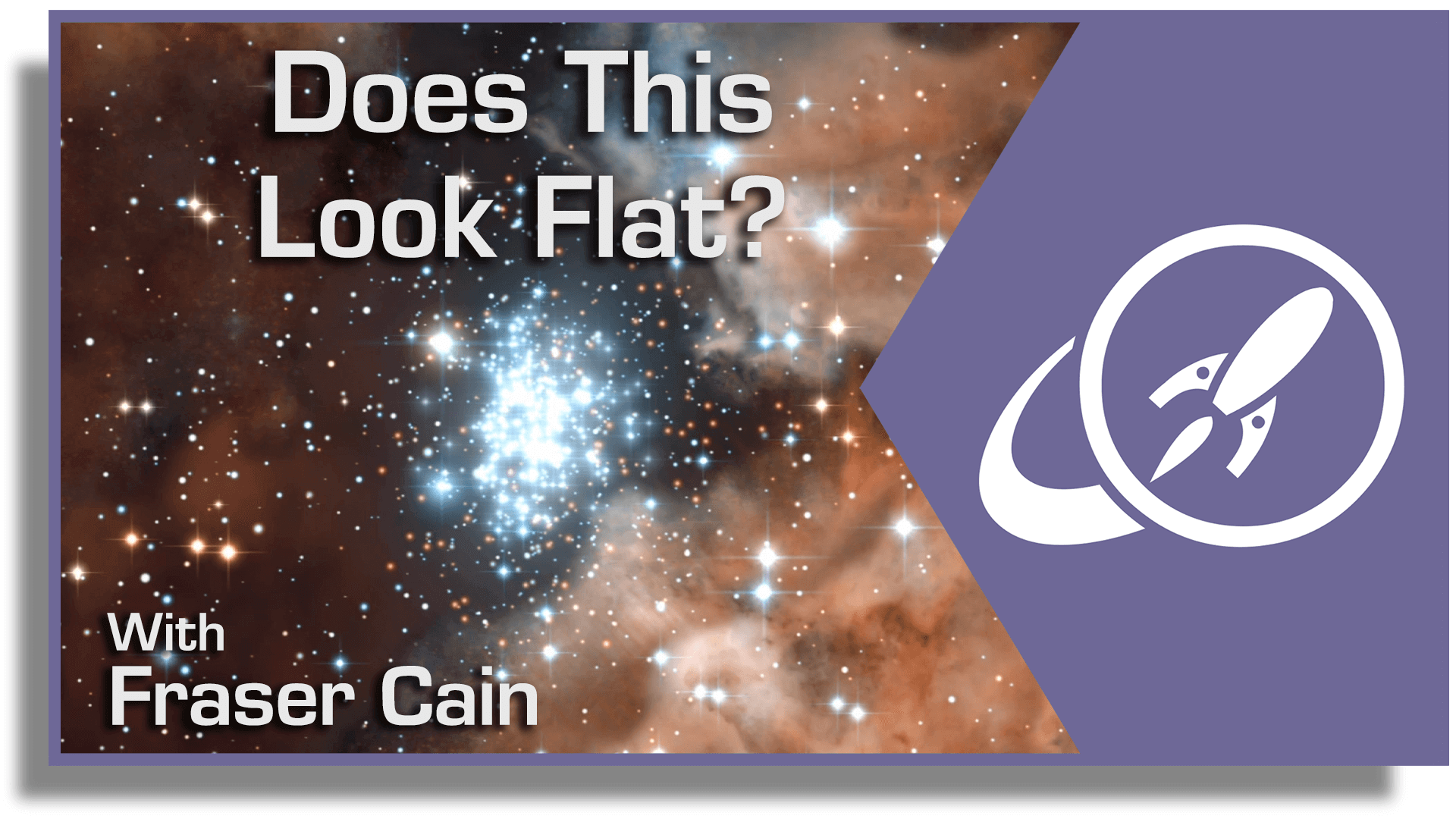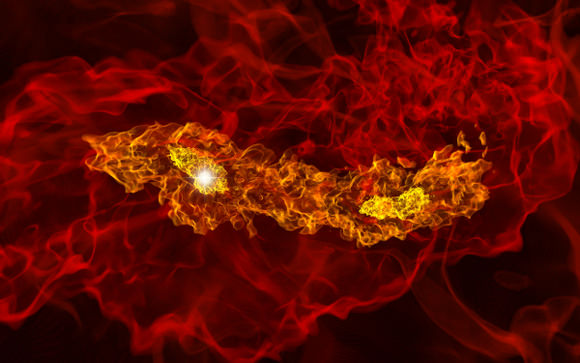Cosmology has had several ground-breaking discoveries over the last 100+ years since Einstein developed his theory of relativity. Two of the most prominent were the discovery of the Cosmic Microwave Background (CMB) in 1968 and the confirmation of gravitational waves in 2015. Each utilized different tools, but both lent credence to the Big Bang Theory, which relates to the universe’s formation. However, we still don’t understand a vital part of that formation, and a new review paper by Rishav Roshan and Graham White at the University of Southampton suggests that we might be able to make some headway on our one-second “gap” in knowledge by using our newfound understanding of gravitational waves.
Continue reading “How Gravitational Waves Could Let Us See the First Moments After the Big Bang”New Supercomputer Simulations Will Help pin Down Inflation

In the very earliest moments of the big bang, the universe experienced a period of rapid expansion known as inflation. That event planted the seeds that would eventually become galaxies and clusters. And now, a recent set of simulations is able to show us how that connection worked.
Continue reading “New Supercomputer Simulations Will Help pin Down Inflation”How Do We Know the Universe is Flat? Discovering the Topology of the Universe
Whenever we talk about the expanding Universe, everyone wants to know how this is going to end. Sure, they say, the fact that most of the galaxies we can see are speeding away from us in all directions is really interesting. Sure, they say, the Big Bang makes sense, in that everything was closer together billions of years ago.
But how does it end? Does this go on forever? Do galaxies eventually slow down, come to a stop, and then hurtle back together in a Big Crunch? Will we get a non-stop cycle of Big Bangs, forever and ever?
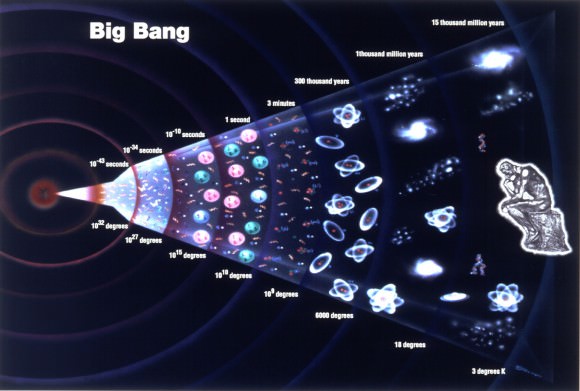
We’ve done a bunch of articles on many different aspects of this question, and the current conclusion astronomers have reached is that because the Universe is flat, it’s never going to collapse in on itself and start another Big Bang.
But wait, what does it mean to say that the Universe is “flat”? Why is that important, and how do we even know?
Before we can get started talking about the flatness of the Universe, we need to talk about flatness in general. What does it mean to say that something is flat?
If you’re in a square room and walk around the corners, you’ll return to your starting point having made 4 90-degree turns. You can say that your room is flat. This is Euclidian geometry.
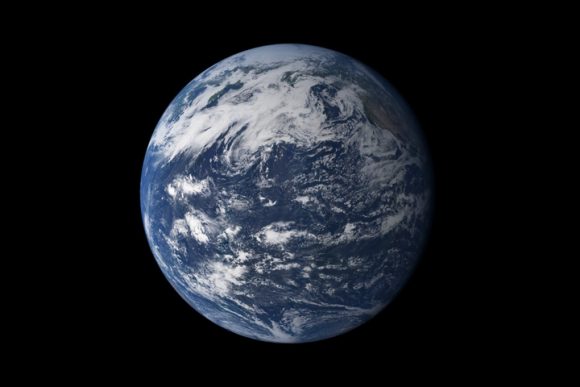
But if you make the same journey on the surface of the Earth. Start at the equator, make a 90-degree turn, walk up to the North Pole, make another 90-degree turn, return to the equator, another 90-degree turn and return to your starting point.
In one situation, you made 4 turns to return to your starting point, in another situation it only took 3. That’s because the topology of the surface you were walking on decided what happens when you take a 90-degree turn.
You can imagine an even more extreme example, where you’re walking around inside a crater, and it takes more than 4 turns to return to your starting point.
Another analogy, of course, is the idea of parallel lines. If you fire off two parallel lines at the North pole, they move away from each other, following the topology of the Earth and then come back together.
Got that? Great.
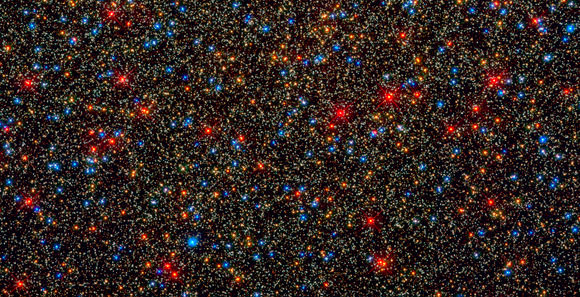
Now, what about the Universe itself? You can imagine that same analogy. Imaging flying out into space on a rocket for billions of light-years, performing 90-degree maneuvers and returning to your starting point.
You can’t do it in 3, or 5, you need 4, which means that the topology of the Universe is flat. Which is totally intuitive, right? I mean, that would be your assumption.
But astronomers were skeptical and needed to know for certain, and so, they set out to test this assumption.
In order to prove the flatness of the Universe, you would need to travel a long way. And astronomers use the largest possible observation they can make. The Cosmic Microwave Background Radiation, the afterglow of the Big Bang, visible in all directions as a red-shifted, fading moment when the Universe became transparent about 380,000 years after the Big Bang.

When this radiation was released, the entire Universe was approximately 2,700 C. This was the moment when it was cool enough for photons were finally free to roam across the Universe. The expansion of the Universe stretched these photons out over their 13.8 billion year journey, shifting them down into the microwave spectrum, just 2.7 degrees above absolute zero.
With the most sensitive space-based telescopes they have available, astronomers are able to detect tiny variations in the temperature of this background radiation.
And here’s the part that blows my mind every time I think about it. These tiny temperature variations correspond to the largest scale structures of the observable Universe. A region that was a fraction of a degree warmer become a vast galaxy cluster, hundreds of millions of light-years across.
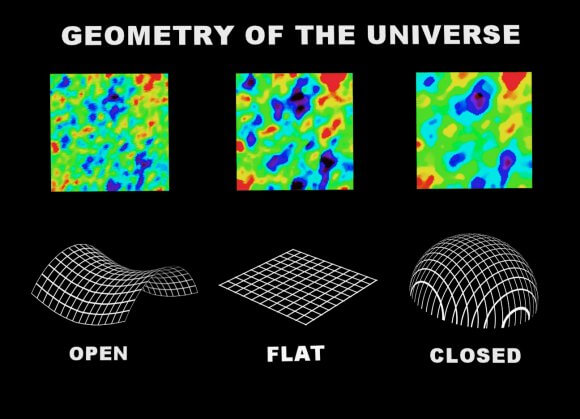
The Cosmic Microwave Background Radiation just gives and gives, and when it comes to figuring out the topology of the Universe, it has the answer we need. If the Universe was curved in any way, these temperature variations would appear distorted compared to the actual size that we see these structures today.
But they’re not. To best of its ability, ESA’s Planck space telescope, can’t detect any distortion at all. The Universe is flat.
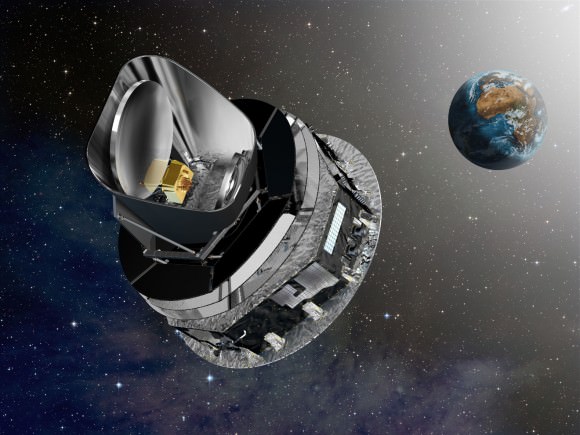
Well, that’s not exactly true. According to the best measurements astronomers have ever been able to make, the curvature of the Universe falls within a range of error bars that indicates it’s flat. Future observations by some super Planck telescope could show a slight curvature, but for now, the best measurements out there say… flat.
We say that the Universe is flat, and this means that parallel lines will always remain parallel. 90-degree turns behave as true 90-degree turns, and everything makes sense.
But what are the implications for the entire Universe? What does this tell us?
Unfortunately, the biggest thing is what it doesn’t tell us. We still don’t know if the Universe is finite or infinite. If we could measure its curvature, we could know that we’re in a finite Universe, and get a sense of what its actual true size is, out beyond the observable Universe we can measure.
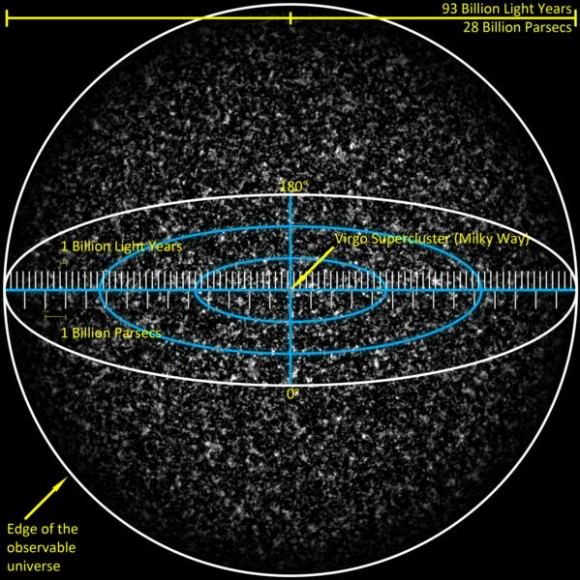
We know that the volume of the Universe is at least 100 times more than we can observe. At least. If the flatness error bars get brought down, the minimum size of the Universe goes up.
And remember, an infinite Universe is still on the table.
Another thing this does, is that it actually causes a problem for the original Big Bang theory, requiring the development of a theory like inflation.
Since the Universe is flat now, it must have been flat in the past, when the Universe was an incredibly dense singularity. And for it to maintain this level of flatness over 13.8 billion years of expansion, in kind of amazing.
In fact, astronomers estimate that the Universe must have been flat to 1 part within 1×10^57 parts.
Which seems like an insane coincidence. The development of inflation, however, solves this, by expanding the Universe an incomprehensible amount moments after the Big Bang. Pre and post inflation Universes can have vastly different levels of curvature.
In the olden days, cosmologists used to say that the flatness of the Universe had implications for its future. If the Universe was curved where you could complete a full journey with less than 4 turns, that meant it was closed and destined to collapse in on itself.
And it was more than 4 turns, it was open and destined to expand forever.
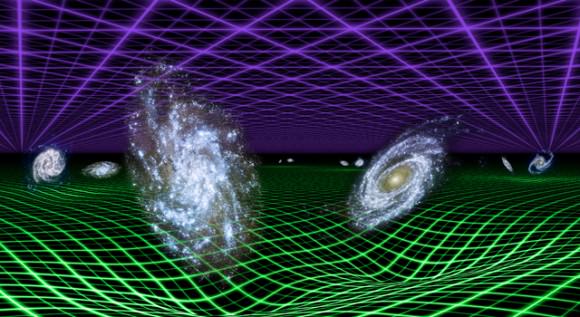
Well, that doesn’t really matter any more. In 1998, the astronomers discovered dark energy, which is this mysterious force accelerating the expansion of the Universe. Whether the Universe is open, closed or flat, it’s going to keep on expanding. In fact, that expansion is going to accelerate, forever.
I hope this gives you a little more understanding of what cosmologists mean when they say that the Universe is flat. And how do we know it’s flat? Very precise measurements in the Cosmic Microwave Background Radiation.
Is there anything that all pervasive relic of the early Universe can’t do?
Cosmologist Thinks a Strange Signal May Be Evidence of a Parallel Universe
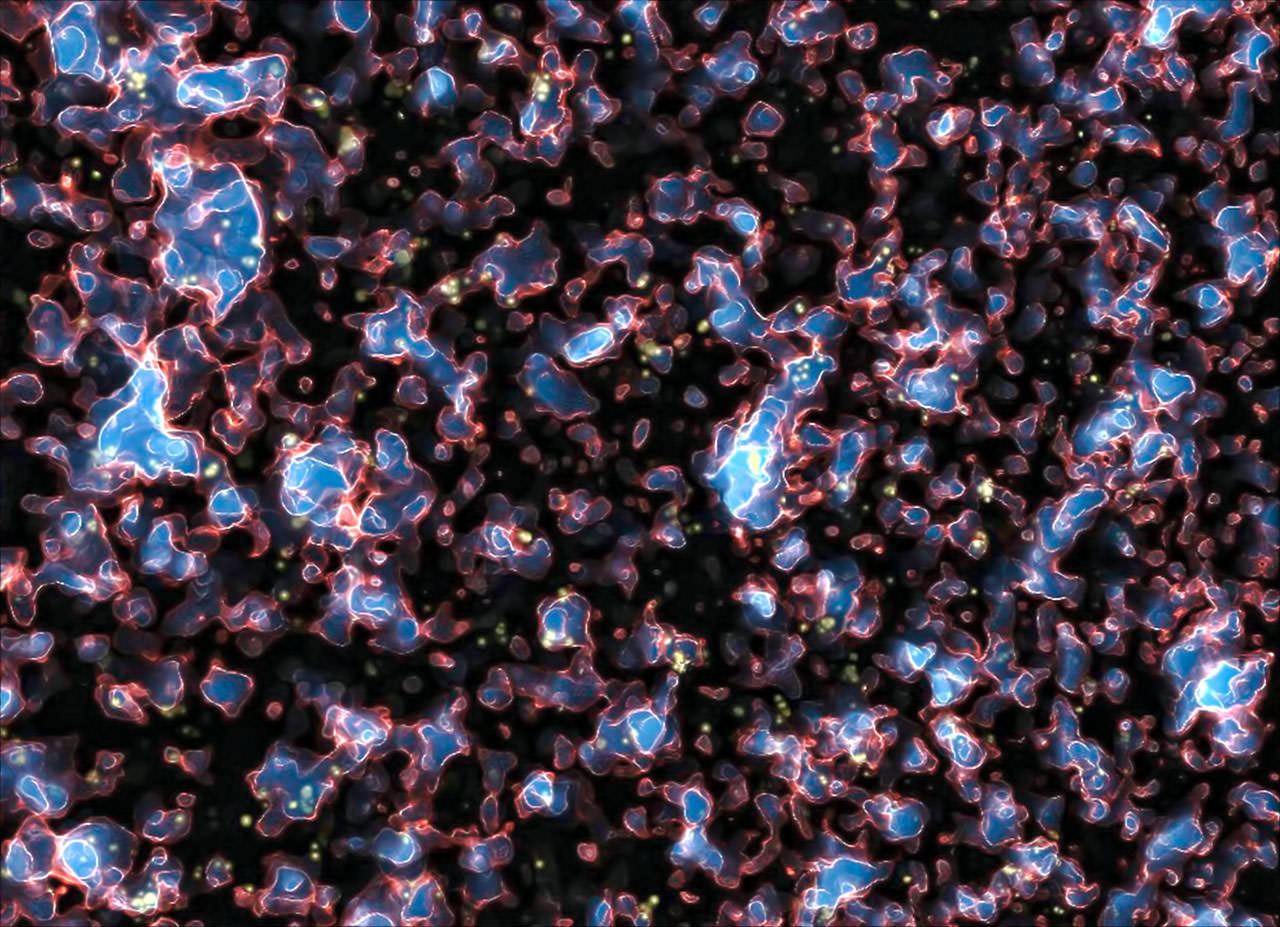
In the beginning, there was chaos.
Hot, dense, and packed with energetic particles, the early Universe was a turbulent, bustling place. It wasn’t until about 300,000 years after the Big Bang that the nascent cosmic soup had cooled enough for atoms to form and light to travel freely. This landmark event, known as recombination, gave rise to the famous cosmic microwave background (CMB), a signature glow that pervades the entire sky.
Now, a new analysis of this glow suggests the presence of a pronounced bruise in the background — evidence that, sometime around recombination, a parallel universe may have bumped into our own.
Although they are often the stuff of science fiction, parallel universes play a large part in our understanding of the cosmos. According to the theory of eternal inflation, bubble universes apart from our own are theorized to be constantly forming, driven by the energy inherent to space itself.
Like soap bubbles, bubble universes that grow too close to one another can and do stick together, if only for a moment. Such temporary mergers could make it possible for one universe to deposit some of its material into the other, leaving a kind of fingerprint at the point of collision.
Ranga-Ram Chary, a cosmologist at the California Institute of Technology, believes that the CMB is the perfect place to look for such a fingerprint.
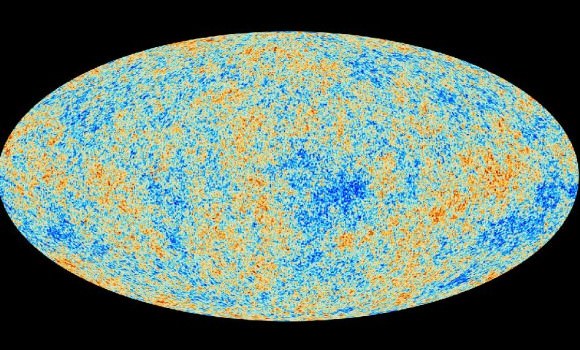
After careful analysis of the spectrum of the CMB, Chary found a signal that was about 4500x brighter than it should have been, based on the number of protons and electrons scientists believe existed in the very early Universe. Indeed, this particular signal — an emission line that arose from the formation of atoms during the era of recombination — is more consistent with a Universe whose ratio of matter particles to photons is about 65x greater than our own.
There is a 30% chance that this mysterious signal is just noise, and not really a signal at all; however, it is also possible that it is real, and exists because a parallel universe dumped some of its matter particles into our own Universe.
After all, if additional protons and electrons had been added to our Universe during recombination, more atoms would have formed. More photons would have been emitted during their formation. And the signature line that arose from all of these emissions would be greatly enhanced.
Chary himself is wisely skeptical.
“Unusual claims like evidence for alternate Universes require a very high burden of proof,” he writes.
Indeed, the signature that Chary has isolated may instead be a consequence of incoming light from distant galaxies, or even from clouds of dust surrounding our own galaxy.
SO is this just another case of BICEP2? Only time and further analysis will tell.
Chary has submitted his paper to the Astrophysical Journal. A preprint of the work is available here.
New Cosmological Theory Goes Inflation-Free

The Cosmic Microwave Background (CMB) radiation is one of the greatest discoveries of modern cosmology. Astrophysicist George Smoot once likened its existence to “seeing the face of God.” In recent years, however, scientists have begun to question some of the attributes of the CMB. Peculiar patterns have emerged in the images taken by satellites such as WMAP and Planck – and they aren’t going away. Now, in a paper published in the December 1 issue of The Astronomical Journal, one scientist argues that the existence of these patterns may not only imply new physics, but also a revolution in our understanding of the entire Universe.
Let’s recap. Thanks to a blistering ambient temperature, the early Universe was blanketed in a haze for its first 380,000 years of life. During this time, photons relentlessly bombarded the protons and electrons created in the Big Bang, preventing them from combining to form stable atoms. All of this scattering also caused the photons’ energy to manifest as a diffuse glow. The CMB that cosmologists see today is the relic of this glow, now stretched to longer, microwave wavelengths due to the expansion of the Universe.
As any fan of the WMAP and Planck images will tell you, the hallmarks of the CMB are the so-called anisotropies, small regions of overdensity and underdensity that give the picture its characteristic mottled appearance. These hot and cold spots are thought to be the result of tiny quantum fluctuations born at the beginning of the Universe and magnified exponentially during inflation.

Given the type of inflation that cosmologists believe occurred in the very early Universe, the distribution of these anisotropies in the CMB should be random, on the order of a Gaussian field. But both WMAP and Planck have confirmed the existence of certain oddities in the fog: a large “cold spot,” strange alignments in polarity known as quadrupoles and octupoles, and, of course, Stephen Hawking’s initials.
In his new paper, Fulvio Melia of the University of Arizona argues that these types of patterns (Dr. Hawking’s signature notwithstanding) reveal a problem with the standard inflationary picture, or so-called ΛCDM cosmology. According to his calculations, inflation should have left a much more random assortment of anisotropies than the one that scientists see in the WMAP and Planck data. In fact, the probability of these particular anomalies lining up the way they do in the CMB images is only about 0.005% for a ΛCDM Universe.
Melia posits that the anomalous patterns in the CMB can be better explained by a new type of cosmology in which no inflation occurred. He calls this model the R(h)=ct Universe, where c is the speed of light, t is the age of the cosmos, and R(h) is the Hubble radius – the distance beyond which light will never reach Earth. (This equation makes intuitive sense: Light, traveling at light speed (c) for 13.7 billion years (t), should travel an equivalent number of light-years. In fact, current estimates of the Hubble radius put its value at about 13.4 billion light-years, which is remarkably close to the more tightly constrained value of the Universe’s age.)
R(h)=ct holds true for both the standard cosmological scenario and Melia’s model, with one crucial difference: in ΛCDM cosmology, this equation only works for the current age of the Universe. That is, at any time in the distant past or future, the Universe would have obeyed a different law. Scientists explain this odd coincidence by positing that the Universe first underwent inflation, then decelerated, and finally accelerated again to its present rate.
Melia hopes that his model, a Universe that requires no inflation, will provide an alternative explanation that does not rely on such fine-tuning. He calculates that, in a R(h)=ct Universe, the probability of seeing the types of strange patterns that have been observed in the CMB by WMAP and Planck is 7–10%, compared with a figure 1000 times lower for the standard model.
So, could this new way of looking at the cosmos be a death knell for ΛCDM? Probably not. Melia himself cites a few less earth-shattering explanations for the anomalous signals in the CMB, including foreground noise, statistical biases, and instrumental errors. Incidentally, the Planck satellite is scheduled to release its latest image of the CMB this week at a conference in Italy. If these new results show the same patterns of polarity that previous observations did, cosmologists will have to look into each possible explanation, including Melia’s theory, more intensively.
Higgs Boson Threatened The Early Universe, But Gravity Saved The Day
All the physical properties of our Universe – indeed, the fact that we even exist within a Universe that we can contemplate and explore – owe to events that occurred very early in its history. Cosmologists believe that our Universe looks the way it does thanks to a rapid period of inflation immediately before the Big Bang that smoothed fluctuations in the vacuum energy of space and flattened out the fabric of the cosmos itself.
According to current theories, however, interactions between the famed Higgs boson and the inflationary field should have caused the nascent Universe to collapse. Clearly, this didn’t happen. So what is going on? Scientists have worked out a new theory: It was gravity that (literally) held it all together.
The interaction between the curvature of spacetime (more commonly known as gravity) and the Higgs field has never been well understood. Resolving the apparent problem of our Universe’s stubborn existence, however, provides a good excuse to do some investigating. In a paper published this week in Physical Review Letters, researchers from the University of Copenhagen, the University of Helsinki, and Imperial College London show that even a small interaction between gravity and the Higgs would have been sufficient to stave off a collapse of the early cosmos.
The researchers modified the Higgs equations to include the effect of gravity generated by UV-scale energies. These corrections were found to stabilize the inflationary vacuum at all but a narrow range of energies, allowing expansion to continue and the Universe as we know it to exist… without the need for new physics beyond the Standard Model.
This new theory is based on the controversial evidence of inflation announced by BICEP2 earlier this summer, so its true applicability will depend on whether or not those results turn out to be real. Until then, the researchers are hoping to support their work with additional observational studies that seek out gravitational waves and more deeply examine the cosmic microwave background.
At this juncture, the Higgs-gravity interaction is not a testable hypothesis because the graviton (the particle that handles all of gravity’s interactions) itself has yet to be detected. Based purely on the mathematics, however, the new theory presents an elegant and efficient solution to the potential conundrum of why we exist at all.
Has the Cosmology Standard Model become a Rube Goldberg Device?
This week at the Royal Astronomical Society’s National Astronomy Meeting in the UK, physicists are challenging the evidence for the recent BICEP2 results regarding the inflation period of the Universe, announced just 90 days ago. New research is laying doubt upon the inclusion of inflation theory in the Standard Cosmological Model for understanding the forces of nature, the nature of elementary particles and the present state of the known Universe.
Back on March 17, 2014, it seemed the World was offered a glimpse of an ultimate order from eons ago … actually from the beginning of time. BICEP2, the single purpose machine at the South Pole delivered an image that after analysis, and subtraction of estimated background signal from the Milky Way, lead its researchers to conclude that they had found the earliest remnant from the birth of the Universe, a signature in ancient light that supported the theory of Inflation.
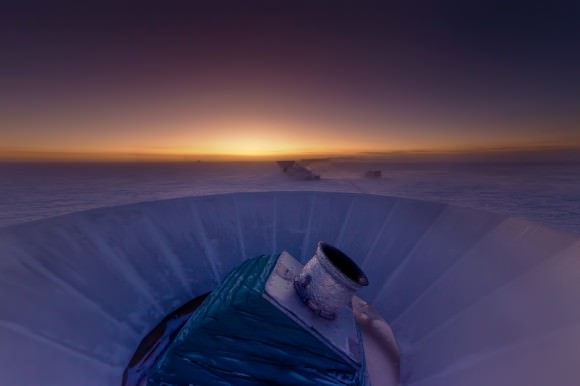
Thirty years ago, the Inflation theory was conceived by physicists Alan Guth and Andei Linde. Guth, Linde and others realized that a sudden expansion of the Universe at only 1/1000000000000000000000000000000000th of a second after the Big Bang could solve some puzzling mysteries of the Cosmos. Inflation could explain the uniformity of the cosmic background radiation. While images such as from the COBE satellite show a blotchy distribution of radiation, in actuality, these images accentuate extremely small variations in the background radiation, remnants from the Big Bang, variations on the order of 1/100,000th of the background level.
Note that the time of the Universe’s proposed Inflationary period immediately after the Big Bang would today permit light to travel only 1/1000000000000000th of the diameter of the Hydrogen atom. The Universe during this first moment of expansion was encapsulated in a volume far smaller than the a single atom.
Emotions ran very high when the BICEP2 team announced their findings on March 17 of this year. The inflation event that the background radiation data supported is described as a supercooling of the Cosmos however, there were physicists that simply remained cool and remained contrarians to the theory. Noted British Physicist Sir Roger Primrose was one who remained underwhelmed and stated that the incredible circular polarization of light that remained in the processed data from BICEP2 could be explained by the interaction of dust, light and magnetic fields in our own neighborhood, the Milky Way.

Now, new observations from another detector, one on the Planck Satellite orbiting the Earth, is revealing that the contribution of background radiation from local sources, the dust in the Milky Way, is appearing to have been under-estimated by the BICEP2 team. All the evidence is not yet laid out but the researchers are now showing reservations. At the same time, it does not dismiss the Inflation Theory. It means that more observations are needed and probably with greater sensitivity.
So why ask the question, are physicists constructing a Rube Goldberg device?
Our present understanding of the Universe stands upon what is called “the Standard Model” of Cosmology. At the Royal Astronomical Society meeting this week, the discussions underfoot could be revealing a Standard Model possibly in a state of collapse or simply needing new gadgets and mechanisms to remain the best theory of everything.
Also this week, new data further supports the discovery of the Higg’s Boson by the Large Hadron Collider in 2012, the elementary particle whose existence explains the mass of fundamental particles in nature and that supports the existence of the Higgs Field vital to robustness of the Standard Model. However, the Higgs related data is also revealing that if the inflationary period of the Universe did take place, then if taken with the Standard Model, one can conclude that the Universe should have collapsed upon itself and our very existence today would not be possible.
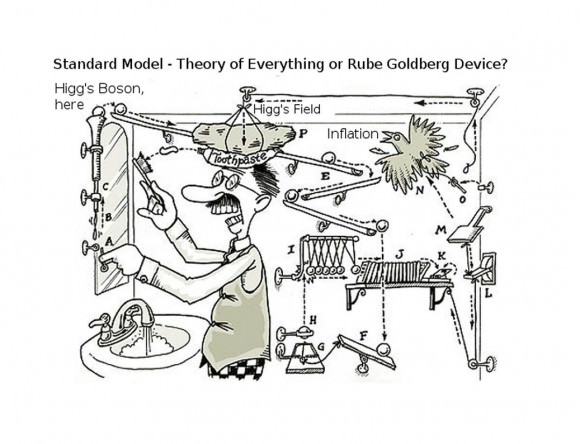
Dr. Brian Green, a researcher in the field of Super String Theory and M-Theory and others such as Dr. Stephen Hawking, are quick to state that the Standard Model is an intermediary step towards a Grand Unified Theory of everything, the Universe. The contortion of the Standard Model, into a sort of Rube Goldberg device can be explained by the undaunting accumulation of more acute and diverse observations at cosmic and quantum scales.
Discussions at the Royal Astronomical Society meeting are laying more doubts upon the inflation theory which just 90 days ago appeared so well supported by BICEP2 – data derived by truly remarkable cutting edge electronics developed by NASA and researchers at the California Institute of Technology. The trials and tribulations of these great theories to explain everything harken back to the period just prior to Einstein’s Miracle Year, 1905. Fragmented theories explaining separately the forces of nature were present but also the accumulation of observational data had reached a flash point.
Today, observations from BICEP2, NASA and ESA great space observatories, sensitive instruments buried miles underground and carefully contrived quantum experiments in laboratories are making the Standard Model more stressed in explaining everything, the same model so well supported by the Higg’s Boson discovery just two years ago. Cosmologists concede that we may never have a complete, proven theory of everything, one that is elegant; however, the challenges upon the Standard Model and inflation will surely embolden younger theorists to double the efforts in other theoretical work.
For further reading:
RAS NAM press release: Should the Higgs Boson Have Caused our Universe To Collapse?
We’ve Discovered Inflation!: Now What?
Cosmologists Cast Doubt on Inflation Evidence
Are the BICEP2 Results Invalid? Probably Not
Why Inflation Didn’t Get the Same Hype as the Higgs
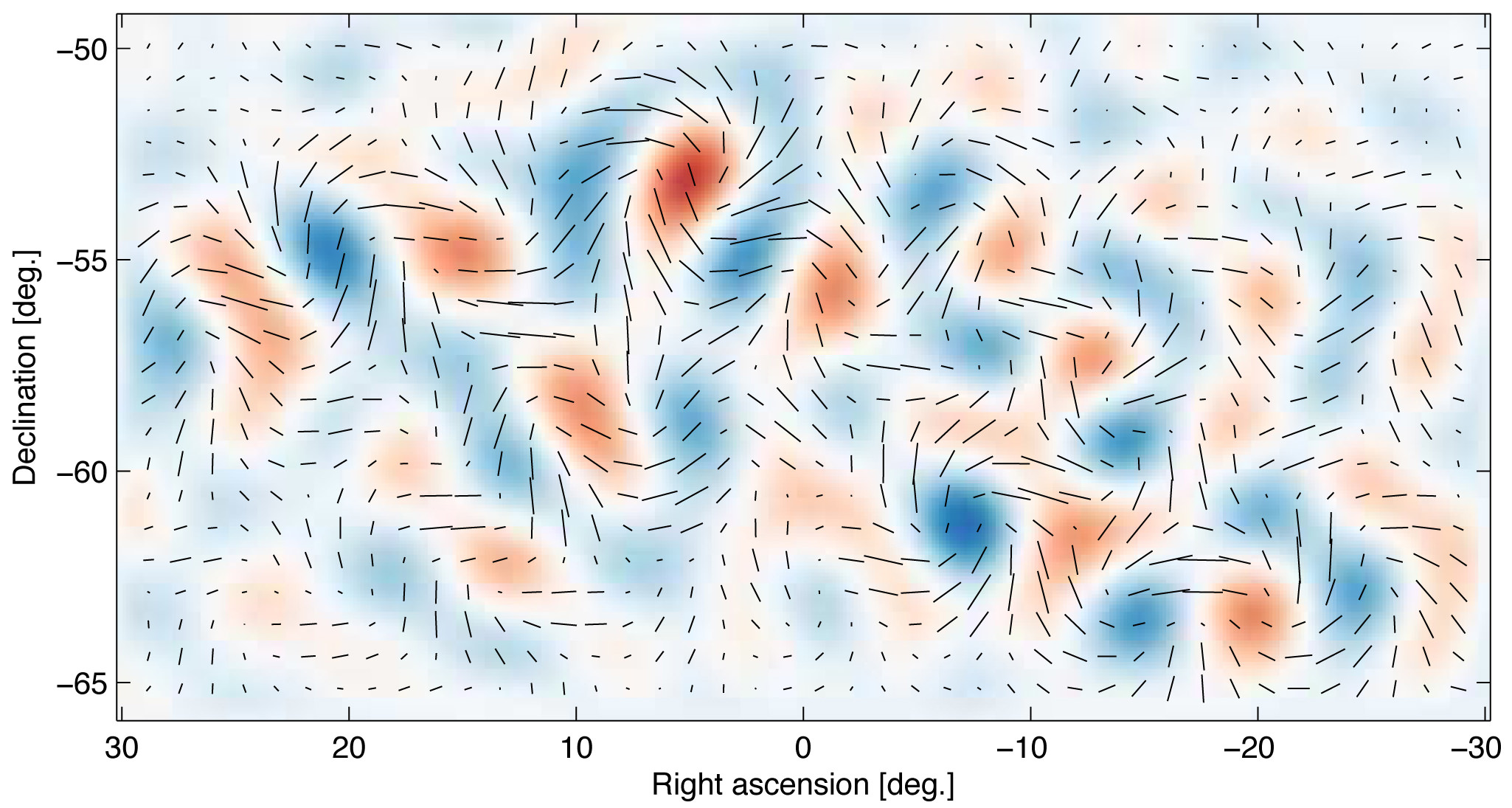
Last month astronomers provided evidence that the universe underwent a brief but stupendous expansion at the very beginning of time. It was a landmark discovery. And while the media worldwide gleamed with fantastical headlines, I’m left overwhelmed with the feeling that it didn’t quite get the spotlight it deserves.
The day of the announcement was ablaze with excitement. When I first started to cover the news, I told my mother I was writing on something that was bigger than the Higgs boson. That was the best way I could explain the significance of this monumental discovery to someone with very little physics knowledge in a text message.
But inflation didn’t get the same hype as the Higgs. Why?
Scientific results are mostly tangible. The Higgs boson was created in a 27-kilometer ring of superconducting magnets designed to boost the energy of particles — marking the world’s largest and most powerful particle accelerator. There’s something about this experiment that we can wrap our minds around, even when the particle itself remains elusive. The $10 billion effort has 6,000 researchers working hard to control the system.
But we can’t control the universe. We can’t ask two galaxies to collide; We can’t speed up stellar evolution; And we can’t pull a nearby star a little closer to take a peek at its circling exoplanet. Instead we stand on our cosmic platform and wait for the light from various happenings to reach us. Once it does, we dig through that light — collecting photons in different filters or spreading them across a spectrum of wavelengths — reaping every last bit of knowledge possible.
Astronomical research is complex and abstract. But it’s what we love about it.
The vast cosmic arena — with its unimaginable vistas of time and space — is laid out in the small specks of light on the celestial sphere. By collecting this light we have placed ourselves within the cosmos. We know the universe began with the Big Bang nearly 13.8 billion years ago. We know that dark matter binds massive galaxy clusters together and that dark energy is causing the universe to accelerate rapidly. It’s truly phenomenal that so much can be learned from the study of light.
Still, there’s a fundamental difference between observing the direct light emitted from distant stars and galaxies and observing a slight polarization pattern on the cosmic microwave background — the radiation released 380,000 years after the Big Bang when photons were able to travel freely across the cosmos.
The result threw open a new window on the birth of the universe. To be more precise, it let us peer back at the moment that took place a mere trillionth of a trillionth of a trillionth of a second after the Big Bang. But it takes so many steps (potentially as many steps as seconds from then until now) to grasp this hazy and mind-boggling concept. It will stretch your ideas of space and time to their limits.
Not only does this result succeed in showing the universe in its infancy, explaining the origin of cosmic structure and providing evidence for the last untested prediction of Albert Einstein’s General Theory of Relativity (gravity comes in discrete packets like light), but it makes an even wilder prediction.
The model likely produces not just one universe, but rather an ensemble of universes: an endless series of big bangs that continue to pop up eternally. Our universe may just be one bubble out of a vast cosmic ocean of others.
Astronomy is moving further toward the abstract. Both in how we collect data and the scientific results we carefully and slowly unearth from that data.
I find this awe-inspiring. But while astronomers are finding ingenious and creative methods to further understand the phenomenal universe in which we live, science journalists and educators are going to have to follow suit. We need to act not as translators but as guides who map scientific knowledge, finding paths through vast amounts of abstract information and analyzing key points along the way. Only then will inflation trump the Higgs and the abstract become tangible.
But honestly I’m still ruminating on this question so all additional thoughts are welcome.
Watch Live Webcast: Secrets of the Universe’s First Light
Just a month ago came the news of the first direct evidence of primordial gravitational waves — ripples in the fabric of spacetime — providing the first direct evidence the Universe underwent a brief but stupendously accelerated expansion immediately following the Big Bang.
This almost unimaginably fast expansion when the Universe was only a trillionth of a trillionth of a trillionth of a second was first theorized more than three decades ago, and the announcement last month was so monumental that some are comparing it to the discovery of the Higgs boson.
On April 18, 20:00 UTC (3 pm EDT, 1:00 pm PDT, two of the scientists who made this groundbreaking discovery will come together for a conversation with two of the pioneering leaders of the field. Together, they will examine the detection of a distinctive, swirling pattern in the universe’s first light, what the swirl tells us about that monumental growth spurt, and the many implications on the way we understand the universe around us.
You can watch below:
The hangout will include members of the BICEP2, which made the discovery, as well as two notable scientists in this field, John Carlstrom and Michael Turner.
Weekly Space Hangout – March 21, 2014: Cosmos & Gravitational Waves!
Host: Fraser Cain
Guests: Matthew Francis, Nicole Gugliucci, Brian Koberlein, Morgan Rehnberg, Mike Simmons
Continue reading “Weekly Space Hangout – March 21, 2014: Cosmos & Gravitational Waves!”


